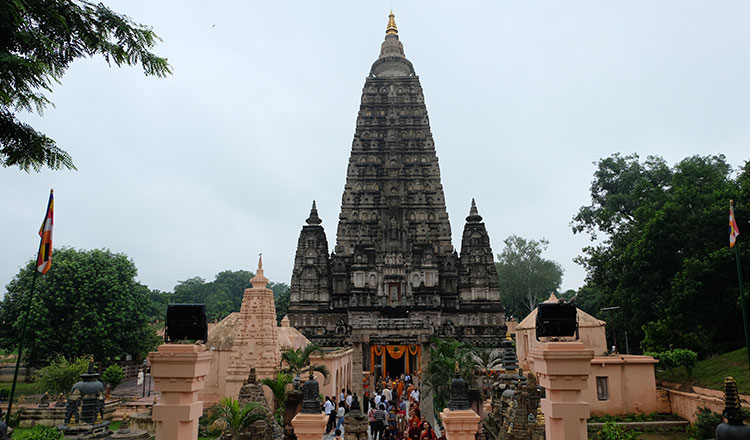TRAVEL-RELIGION: BUDDHISM – Tracing Buddha’s Path
The Indian government, in partnership with Japan, gathered hundreds of people from around the globe to celebrate the teachings of the Lord Buddha in last week’s International Buddhist Conclave. Now in its sixth edition, the four-day event was filled with religious tourism discussions, business-to-business meetings between Indian and foreign travel agencies, and visits to several Indian states that bear the sacred history of Prince Siddhartha Gautama and his path towards enlightenment. Agnes Alpuerto joined the conclave.
.
It all started about 2,500 years ago, when Prince Siddhartha Gautama was born in the gardens of Lumbini in modern-day Nepal. The prince, though living with a joyful and wealthy life, was troubled with the sufferings of humanity outside his palace. He questioned sickness and death, and how these pains seemed to be innate and inevitable parts of human life. He set out on a journey to India to find full enlightenment and freedom, which would soon pave a solid path for over 500 million people who also believed in the attainment of nirvana.
In New Delhi last week, the Indian government, in partnership with Japan, brought together more than 200 delegates from 30 countries to celebrate this path, learn deeper about its beginnings, and share the teachings Buddha had spread through his lifetime.

Inaugurated by Indian President Shri Ram Nath Kovind on August 23 at the Vigyan Bhawan, the 6th International Buddhist Conclave saw members of the Buddhist sector, media organisations, travel and tour agencies and the governments from Cambodia, Japan, Sri Lanka, Thailand, Australia, Vietnam, Russia, China, Bhutan, Myanmar, Indonesia, Singapore and several other nations where the teachings of Lord Buddha are widely recognised and practiced.
The Indian president emphasised how much the present world needs ultimate peace and freedom, the very foundation of Buddhism.
“The spread of Buddhism from India to Asia and to the world carried more than spiritual essence. Buddhism is about knowledge, wisdom, arts, crafts, meditation techniques. In this sense, Buddhism is one of the earliest forms of globalisation.
“While we take advantage of our strengths, we also need to tackle issues that are limiting us from scaling up. We need to lead people, the society, the world, the economy and tourism to a more enlightened path. Buddha’s teachings must continue to guide us through all these,” said President Shri Ram Nath Kovind after the lighting of lamp on the stage, a symbol of the enlightened path the Lord Buddha has bestowed upon his believers.
During the four-day conclave, the large delegation were given a wide platform to connect with local and foreign tour operators and investors, share journalism techniques on Buddhist reporting, and promote and upscale tourism in various Indian states through actual site visits and guided tours.
There was no shortage of activities, and in every place the delegates stepped their feet into, the warm Indian hospitality always exceeded expectations. Is there a warmer and more sincere welcome than a symbolic water salute on the plane, petal-strewn pathway from the jet bridge to the arrival gate and a live band?
Maharashtra

On the second day of the conclave, delegates flew from New Delhi to the state of Maharashtra in the west-central part of India. In the states’ tourism capital, Aurangabad, people were able to tour around the storied Ajanta Caves.
The caves, a series of 29 Buddhist rock-cut cave temples, were discovered in 1819. But it is believed that the caves were built in two phases starting around 200 BC, with the second group of caves built around 600 AD. The Ajanta Caves were used by Buddhist monks as prayer halls and monasteries for about nine centuries before they were abandoned.
Each cave, now restored beautifully and bore instructional signages for visitors to not cause any destruction to the important Buddhist site, features exquisite wall and ceiling paintings that depict the history of Buddhism and of the long forgotten era of India. Different statues of Buddha had also been installed inside the caves, giving them solemn and soulful vibes.
And inside Cave 26, a huge statue of the reclining Buddha had been placed – with his face so serene, calm and steady. The reclining Buddha signifies his death, his entry to parinirvana.
“This is an important site for all Buddhists. Many of Buddha’s followers come to this place to see for themselves the intricate paintings that show many kinds of information – classical arts, ornaments, architecture, hairstyles, textures, customs – of the history of India,” explained Borale Shakar, an Aurangabad-based tour guide.
He shared that the Ajanta Caves usually get the bulk of visitors from October to February, when India has favourable weather conditions for the long walk around the 29 caves.
But with a panoramic view of lush green trees, tall mountains and a sparkling river, the three-hour tour is but worth every sweat.
The Ajanta Caves were declared a UNESCO World Heritage Site in 1983.

BiharConsidered as one of the most important and sacred pilgrimage sites in the world, the village of Bodhgaya in the state of Bihar is less than a two-hour flight from Aurangabad.
Bodhgaya holds with it a holy history for many Buddhists, with it being the place where Prince Siddhartha Gautama attained enlightenment after a 49-day meditation beneath the Bodhi Tree. It is the place where the prince became the Lord Buddha, and set the start of Buddhism across India and the world.
The 50-meter sandstone Mahabodhi Temple, where a gold image of the Lord Buddha in his bhumisparsha mudra is enclosed in a glass, was built in front of the Bodhi Tree. The first temple was built by Mauryan emperor Ashoka, who believed in the teachings of Buddhism in the 3rd century BC.
Both the temple and the sacred Bodhi Tree attract thousands of Buddhist followers and tourists, majority of them monks in saffron and maroon robes who hope to gain the same enlightenment as Prince Siddhartha Guatama did when he was just 35 years old.
Several spots within the boundary of the temple are considered sacred by Buddhists, as they are believed to mark the exact places where the Lord Buddha spent a week meditating and the place where he stood still and gazed at the Bodhi Tree after his enlightenment.

In June 2002, the temple gained the UNESCO World Heritage Site status, which signifies that all the artifacts inside it are legally protected.
Aside from the Mahabodhi Temple in Bodhgaya, Bihar also takes pride in having the historic and sacred sites of Veluvana Mahavihara and the ruins of Nalanda Mahavihara in the scenic town of Rajgir. The ancient site of Veluvana is considered to be the place where the Lord Buddha spent several seasons to meditate and preach. It was a silent witness to many important events that shaped the Sangha of Buddhism, after the Lord Buddha brought his disciples in the place.
Nalanda University, meanwhile, drew scholars from all over Asia before it was destroyed by invaders in 1193. The ancient centre of learning, which was almost leveled to the ground during the attack and now only contains some of its foundations, rooms and stupas, tell the story of the early followers of Buddhism, the students who wanted to learn more about the life of Buddha and their determination to spread his teachings.
“The government and the rest of the world know the history of Nalanda. But we don’t want to give up what remains in here and build a new university in this very site. This is sacred, we want it to remain in here and be a reminder of the early Buddhist studies and philosophy,” said tour guide Nadim Akhtar, adding that a new Nalanda University was built in 2010, still in the town of Rajgir.
Nalanda Mahavira is Bihar’s second UNESCO world heritage site after Mahabodhi Temple.

Revered monks from Cambodia and other nations walk to the Mahabodhi Temple. Photo: Sopheap ChhengUttar Pradesh
Five weeks after becoming the Enlightened One, the Lord Buddha reached the state of Uttar Pradesh – in the small village of Sarnath specifically – where he made his first sermon. Because the Lord Buddha had already given up all his wealth and luxury years before his enlightenment, he didn’t have the money to pay for a ferry ride crossing to Uttar Pradesh. Buddhists believe he crossed the Ganges river through the air.
To continuously hold the sanctity of the spot of Buddha’s first preaching in front of his five disciples, the Dhamek Stupa was built in 500 AD and is still standing tall.
The cylindrical structure, made of red bricks and stones, stands more than 40 meters tall with a diameter of 28 meters. An earlier structure of the stupa was built through the orders of King Ashoka in 249 BC, but it had been built several times over. The lower part of the red stupa comprises intricate carvings that depict humans and birds, as well as inscriptions of the origins of the Gupta period.
Sarnath flourished as a center of education and religious activities for centuries, having many more stupas and several monasteries besides the Dhamek.
But in the 12th century, Sarnath was attacked and razed by invaders, and was only rediscovered in the 1830s.
Aside from Buddhists, believers of Jainism also consider Sarnath as a holy site because of its proximity to Singhpur village, the birthplace of Jainism.







 All photographs, news, editorials, opinions, information, data, others have been taken from the Internet ..aseanews.net |
All photographs, news, editorials, opinions, information, data, others have been taken from the Internet ..aseanews.net | 






